Itinerary edited by UNIVERSITY OF CAGLIARI 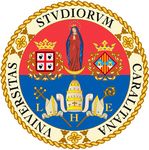

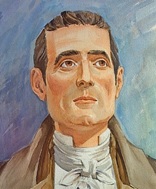 Clemente Michelangelo F. Susini was the son of Lorenzo Susini and Annunziata Vernaccini, born on December 18, 1754 in the neighborhood of SanLorenzo in Florence. Susini started his studies in art at an early age and became an expert in ceroplastics, but also in glass painting, copper incisions, and to do work on scagliola (pigmented plaster). In 1771 he enrolled in the Accademia di Belle Arti and was a model student; in 1772 he was already working in the study of the sculptor Pompilio Ticcianti (1706-1777), when he was noticed by Felice Fontana, who was setting up the ceroplastic workshop of the Regio e Imperiale Museo di Fisica e Storia Naturale (called La Specola) with the support of the Grand-Duke Peter Leopold.
Clemente Michelangelo F. Susini was the son of Lorenzo Susini and Annunziata Vernaccini, born on December 18, 1754 in the neighborhood of SanLorenzo in Florence. Susini started his studies in art at an early age and became an expert in ceroplastics, but also in glass painting, copper incisions, and to do work on scagliola (pigmented plaster). In 1771 he enrolled in the Accademia di Belle Arti and was a model student; in 1772 he was already working in the study of the sculptor Pompilio Ticcianti (1706-1777), when he was noticed by Felice Fontana, who was setting up the ceroplastic workshop of the Regio e Imperiale Museo di Fisica e Storia Naturale (called La Specola) with the support of the Grand-Duke Peter Leopold.
 The modelling technique had been introduced in Florence in 1770 from Bologna by Giuseppe Galletti (1738-1819), surgeon of the Arcispedale di Santa Maria Nuova. Galletti had hired the sculptor Giuseppe Ferrini for the realization of some obstetric and anatomical models that were seen by Fontana. The latter hired Ferrini and the nineteen-year-old Clemente Susini as second modeller and dissector aid and, later on, Antonio Matteucci and the painter Claudio Valvani. The procedure for the realization of models was long and complex. When the museum was opened in 1775, 486 models were exhibited in 137 glass cases placed in six great halls, along with drawings and captions. The workshop’s activity continued even in the five years when Fontana and his assistant Giovanni Fabbroni were on sabbatical in London and Paris; they kept corresponding with the Grand Duke in order to monitor the work. Upon returning, they incremented the production of models by hiring new collaborators and involving Peter Leopold who, as impassionate chemist, prepared new varnishes.
The modelling technique had been introduced in Florence in 1770 from Bologna by Giuseppe Galletti (1738-1819), surgeon of the Arcispedale di Santa Maria Nuova. Galletti had hired the sculptor Giuseppe Ferrini for the realization of some obstetric and anatomical models that were seen by Fontana. The latter hired Ferrini and the nineteen-year-old Clemente Susini as second modeller and dissector aid and, later on, Antonio Matteucci and the painter Claudio Valvani. The procedure for the realization of models was long and complex. When the museum was opened in 1775, 486 models were exhibited in 137 glass cases placed in six great halls, along with drawings and captions. The workshop’s activity continued even in the five years when Fontana and his assistant Giovanni Fabbroni were on sabbatical in London and Paris; they kept corresponding with the Grand Duke in order to monitor the work. Upon returning, they incremented the production of models by hiring new collaborators and involving Peter Leopold who, as impassionate chemist, prepared new varnishes.
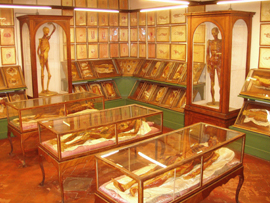
In 1782 Clemente Susini was named head modeller, after Ferrini was fired for being found guilty of fraud, having subtracted silver from the plates used for the models. Before Ferrini left Florence, Susini had collaborated with him in the making of the famous decomposable statue of a life-size pregnant woman (1. 64 meter tall), later known as “Venere de’ Medici.” This gorgeous statue had been much appreciated by Fontana who gave to Ferrini and Susini 266 lire, 13 soldi and 4 denari. Such statue, replicated for the Josephinum was the first of many more “Venuses” present not just in Vienna but also in Budapest, Pavia, and Bologna. Several imitations, including Antonio Serantoni’s (1780-1837), often called Florentine Venuses, were exhibited and viewed for a fee in anatomical museums that became popular mostly in Northern Europe up until the second half of the nineteenth century and beyond.
In years subsequent to 1782, Paolo Mascagni (1755-1815), known for lymphatic studies, Tommaso Bonicoli (1746-1802), and Filippo Uccelli (1770-1832) worked for the Museum as dissectors.
In the ceroplastics workshop work was hard, taking up well over eight hours a day in horrible environmental conditions, due to the toxicity of substances employed; as opposed to the Bolognese wax sculptures that usually contained the skeleton, the Florentine ones did not. According to Tumiati, even though the information is not confirmed, the preservation liquid used on corpses contained arsenic, which had serious consequences for Susini, who got intoxicated. In 1780, the Austrian Emperor Joseph II (1741-1790) older brother of the Grand Duke Peter Leopold, visited La Specola and commissioned such a number of models that Peter Leopold had to refuse, since it would have interfered with the activity of the Museum. The order was later accepted, reluctantly, by Fontana, who organized a second workshop at his house, hired over 200 collaborators, and was helped by Clemente Susini and Paolo Mascagni, who supervised the project. In a luster, 1192 wax models were produced and transported to Vienna between 1784 and 1788. From 1782 to 1785 Susini, under Mascagni’s supervision, produced several lymphatic statues for La Specola that are not signed; among the twelve in the Josephinum only model 191 bears an inscription with his signature under the left armpit. Not only did he participate in the creation of the Viennese wax sculptures, but he corrected some of the mistakes that Mascagni imposed on ceroplasts on purpose in order to differentiate his preparations from Albinus’s. From 1784 on he was flanked by a second modeller: Francesco Calenzuoli (1769-1849). 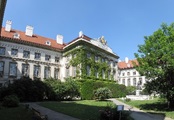 Aside from anatomical waxes, he also produced religious statues and portraits of illustrious people. From 1799 on, he was hired by the Accademia di Belle Arti in Florence, where he taught drawing from live models and administered exams. In the forty years working in the Museum he made or oversaw personally the production of over 2000 models.Aside from the anatomical wax models for La Specola and Vienna, Susini produced other models commissioned to the Museum, by then famous all over Europe. Noteworthy among these are the two decomposable statues of a man and a woman with the preparation of lymphatic vases, ordered by Antonio Scarpa from the University of Pavia, the head with the preparation of the facial nerve made in 1798 for the Muséum d’Histoire Naturelle in Paris, and the anatomical wax collection for the Museum in Cagliari made with the collaboration of the Sardinian anatomist
Aside from anatomical waxes, he also produced religious statues and portraits of illustrious people. From 1799 on, he was hired by the Accademia di Belle Arti in Florence, where he taught drawing from live models and administered exams. In the forty years working in the Museum he made or oversaw personally the production of over 2000 models.Aside from the anatomical wax models for La Specola and Vienna, Susini produced other models commissioned to the Museum, by then famous all over Europe. Noteworthy among these are the two decomposable statues of a man and a woman with the preparation of lymphatic vases, ordered by Antonio Scarpa from the University of Pavia, the head with the preparation of the facial nerve made in 1798 for the Muséum d’Histoire Naturelle in Paris, and the anatomical wax collection for the Museum in Cagliari made with the collaboration of the Sardinian anatomist 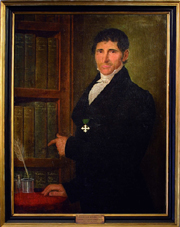 Francesco Antonio Boi (1767-1850). Cagliari waxes represent Clemente Susini’s artistic maturity and are the result of his collaboration with the anatomist Francesco Antonio Boi, who made the dissections. The models, that were made in the workshop of the Museum La Specola in Florence in the years 1803-1805, were commissioned by Carlo Felice of Savoy, Viceroy of Sardinia, via Boi, who was spending a sabbatical year in the anatomy lab of the general hospital (Arcispedale) of Santa Maria Nuova, directed by Paolo Mascagni. In the three years working with Boi, Susini, no longer under the supervision of the old Director, was finally free to express himself: Fontana, in fact, had lost interest in supervising wax works because he was, in his private workshop, engaged in fabricating decomposable wooden models commissioned by Napoleon Bonaparte. Glass cases of Cagliari contain original tags dated and signed by Susini, an authenticity seal absent from the other collections of Florentine waxes, and even from those bought from the University of Bologna in Susini’s workshop in 1810. Aside from being an example of how anatomy can be turned into art, the Susini-Boi models still retain an extraordinary scientific and didactic value, even two centuries later.
Francesco Antonio Boi (1767-1850). Cagliari waxes represent Clemente Susini’s artistic maturity and are the result of his collaboration with the anatomist Francesco Antonio Boi, who made the dissections. The models, that were made in the workshop of the Museum La Specola in Florence in the years 1803-1805, were commissioned by Carlo Felice of Savoy, Viceroy of Sardinia, via Boi, who was spending a sabbatical year in the anatomy lab of the general hospital (Arcispedale) of Santa Maria Nuova, directed by Paolo Mascagni. In the three years working with Boi, Susini, no longer under the supervision of the old Director, was finally free to express himself: Fontana, in fact, had lost interest in supervising wax works because he was, in his private workshop, engaged in fabricating decomposable wooden models commissioned by Napoleon Bonaparte. Glass cases of Cagliari contain original tags dated and signed by Susini, an authenticity seal absent from the other collections of Florentine waxes, and even from those bought from the University of Bologna in Susini’s workshop in 1810. Aside from being an example of how anatomy can be turned into art, the Susini-Boi models still retain an extraordinary scientific and didactic value, even two centuries later.
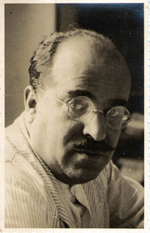
Notwithstanding some acknowledgments, it is only in the early nineteenth century that the modellists’ status changed from artisan to artist. In the first years of activity of the “Ceroplastic Workshop”,Fontana considered modellists as instruments; it is only later, mainly thanks to Giovanni Fabbroni (1752-1822), ex assistant of Fontana’s later turned into his main rival and critic, that modellists, Susini in particular, began to be acknowledged for their role in the production of the Wax Sculptures of La Specola. However, Fontana continued being considered the author of models, as proven by the fact that in 1848 only his name is mentioned in De Renzi’s description of the collection at La Specola. Later on, when wax sculptures lost their popularity at the end of the nineteenth century and in the first half of the twentieth, Susini became utterly unknown. Still today, the wax sculptures of La Specola are associated with Fontana’s name alone in all of Northern Europe. The first historical-scientific essay which mentions Susini’s name as the author of the Florentine waxes is Luigi Castaldi’s (1890-1945), anatomist at the University of Cagliari, written in the early Forties and published posthumously in 1947. Such study, which can still be bought from the original publisher, is widely cited and much appreciated; as Knoefel writes: “this essay has never been surpassed”. Aside from the engagement at the Accademia delle Belle Arti and his work at La Specola, in the last decade before Susini’s death, he produced many anatomical waxes in his own waxwork, as proven by the 24 wax sculptures ordered, from 1810, on by Professor Alessandro Moreschi (1771-1826), still exhibited at the Museo Luigi Cattaneo in Bologna.
In the final years of his life, Susini’s health was compromised by a chronic disease; his economic situation was equally precarious, as shown by the fact that, after his death on September 22 1814, the Grand Duke Ferdinand III granted his widow, Rosa Pieralli, a sustenance pension, recognizing the work done in forty years at the Museum. Of his three sons, only Angiolo survived him by two years; the premature death of his sons was possibly caused by contagion, since their father had contracted tuberculosis in the unhealthy environment of La Specola. After his death, Susini was remembered in an anonymous obituary notice that appeared on the Gazzetta di Firenze on October 15 1814 and in a Latin inscription placed on the marble of his tombstone in the Cloister of Santissima Annunziata in Florence by Count Girolamo Bardi, then Director of the Museum. Both texts are quoted in full by Castaldi, who also relays in translation the Latin inscription written by Bardi: “He surpassed all wax modellers and he won’t be surpassed in posterity”.
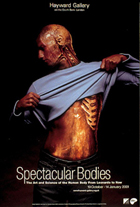
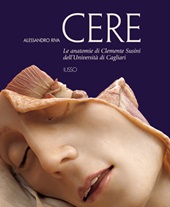
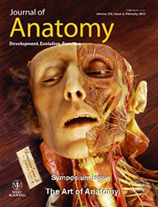
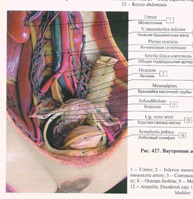

18th December 1754 Birth of Clemente Michelangelo Francesco Susini (CS), also known as Clemente Lorenzo Francesco Susini
1772 He is hired by Felice Fontana, Court physicist of Grand-Duke Peter Leopold of Hapsburg, and Director of La Specola waxworks. CS job is that of second modeler and assistant dissector in the workshop
1782 He is promoted to first modeler of La Specola workshop
1780-1785 He takes part, under the directorship of Paolo Mascagni, in the production of the wax models for the Josephinum Museum of Vienna
1799 He is engaged by the Florence Academy of Fine Arts, where he teaches drawing from life with the task of examiner
1803 He receives from the Vice King of Sardinia Carlo Felice of Savoy, through the Sardinian Anatomist Francesco Antonio Boi (FAB), the commission for a collection of anatomical wax models destined to Vice-Royal Museum of Antiquity and Natural History.
1803-1805 In cooperation with Francesco Antonio Boi, he produced 23 glass windows housing 78 wax preparations which reflect is artistic maturity and the Boi’s anatomical expertize. Each glass window bears Susini’s signature and date
1806 The waxes arrive in Cagliari and are placed in the Vice-royal Museum
22nd September 1814 He dies in Florence of a chronic disease due to the toxic environment of the wax workshop where he worked for over 40 years. During his life, he made or oversaw personally the production of about 2000 models not only for Florence, Vienna and Cagliari, but for other cities such as Budapest, Pavia, Bologna, Montpellier, Paris et cetera, as well
15th October 1814 He is remembered in an anonymous obituary published on the “Gazzetta di Firenze” and in the Latin inscription placed on the marble of his tombstone in the Cloister of Santissima Annunziata in Florence by the Count Girolamo Bardi, then Director of La Specola. The inscription reads: he surpassed all wax modelers and will not be surpassed in posterity
 Vienna
Vienna  Cagliari
CagliariRiva A., Conti G. (2015). Art and Science in the anatomical waxes of Susini-Boi of the University of Cagliari. Museologia Scientifica Memorie, (14), p. 101-107.
Riva A. (2014). Breve biografia di Clemente Susini. In Amendola A., Pastorino U. (Eds.), Le cere vive (p. 111-122). Forlì, FMR-Arca SRl.
Ruggeri A, Leonardi L.(2013). Il Museo delle Cere anatomiche Luigi Cattaneo. In Amazing Bodies: Anatomical Models in European Perspective. Project supported by the European Commission (p. 19-27). Medical University of Vienna, University of Bologna, Boeherave Nuseum, Lejden. www.sma.unibo.it/.
Maerker A. (2011). Model Experts: Wax anatomies and Enlightenment in Florence and Vienna, 1775-1815. Manchester: Manchester University Press.
Riva A, Conti G, Solinas P, Loy F. (2010). The evolution of anatomical illustration and wax modelling in Italy from the XVI to early XIX century. J. Anat., 216, p. 209-222.
Riva A. (2007). Cere, Le anatomie di Clemente Susini dell’Università of Cagliari. Nuoro: Ilisso.
Riva A. (2007). Flesh & Wax. The Clemente Susini’s anatomical wax models in the University of Cagliari. Nuoro: Ilisso.
Musajo Somma L. (2007). In cera. Anatomia e medicina nel XVIII secolo. Bari: Progedit.
Mazzolini R. (2004). Plastic anatomies and artificial dissections. In Chaderavian S., Hopwood N. (Eds.), Models the third dimension of science (p. 43-70). Stanford: Stanford University Press.
Poggesi M. (1999). La collezione ceroplastica del museo “La Specola”. Encyclopedia anatomica, (p. 6-46). Köln: Taschen.
Schmidt G. (1996). Sul contributo di Paolo Mascagni alla collezione viennese di cere anatomiche nel Josephinum. In Vannozzi F. (Ed.), La scienza illuminata. Paolo Mascagni nel suo tempo (1755-1815) (p. 101-110). Siena: Nuova Immagine Editrice.
Lemire M. (1990). Artistes et Mortels. Paris: Chabaud.
Knoefel P.K. (1984). Felice Fontana Life and Works. Trento: Società di Studi Trentini di Scienze Storiche.
Lanza B., Azzaroli Puccetti M.L., Poggesi M., Martelli A. (1979). Le Cere Anatomiche della Specola. Firenze: Arnaud.
Castaldi L. (1947). Francesco Boi (1767-1860), primo cattedratico di Anatomia Umana a Cagliari e le Cere Anatomiche fiorentine di Clemente Susini. Firenze: Leo S. Olschki.